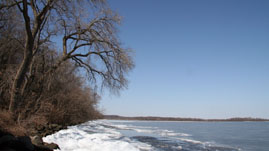Teachers' Domain - Digital Media for the Classroom and Professional Development
User: Preview

Source: Produced by the Wisconsin Educational Communications Board.
This video produced by the Wisconsin Educational Communications Board features University of Wisconsin-Madison researcher John Magnuson, who studies limnology, or the ecology of freshwater systems. He explains the difference between weather and climate using data on ice cover from Lake Mendota in Madison, WI. Analysis of the data indicates a long-term trend that can be connected to climate change.
Look outside—is it warm today? Is it windy, or raining? What was the weather last week like? These day-to-day weather variations play a major role in our lives. Weather impacts what we wear and which activities we undertake; when planning your day it’s often important to consult the weather forecast. Gardeners often talk about the weather over the past weeks or months, and how it has impacted their gardens.
But when we talk about climate change, we rarely use the word “weather,” and with good reason. The difference between weather and climate is one of the most misunderstood parts of climate science. The confusion is understandable—in both cases, the words refer to the same variables: temperature, precipitation, wind speed, humidity, and cloud cover, to name just a few. So how are climate and weather distinct, and why does it matter?
To understand the difference, examine the long-term ice records on Lake Mendota in Madison, WI. At first glance, what one sees is that there is a large amount of variation from year to year. In 1983, Lake Mendota was ice covered just 54 days, while in 1984 there were 111 ice-covered days—more than twice as many. This inter-annual variation is the result of weather—short-term changes that can be seen as random fluctuations around an average value. But as you look more closely, you may notice that the longest ice cover periods all seem to occur at the beginning of the record, and that many of the shortest seem to come at the end. Indeed, a linear trend line plotted through the data shows that, on average, the number of ice-covered days seems to have decreased over the period of record. This long-term trend implies a change in climate.
So weather refers to short-term variability in temperature, precipitation, and other atmospheric processes, while climate refers to long-term average conditions. By definition, when we talk about climate, we are talking about phenomena that take place over a minimum of three decades. When climate scientists say that the climate is warming, then, they don’t mean that the weather on any particular day will be warmer, but rather that the average temperature over many years will increase.
This distinction is why you’ll never hear a climatologist state that a particular storm, or hot day, or other weather event, is the result of climate change. Extreme weather has been a part of life on Earth forever, and will continue. What climate science has found is that certain types of weather events—short winters, heat waves, or extreme storms—will be more likely as the climate changes.
The confusion between climate and weather comes up often as people debate how to react to what climate scientists are predicting for the future. A particularly large snowstorm or hot day might be cited as evidence that a particular course of action is needed. It is important to understand the distinction so we can think critically about which decisions to make as we plan our future.
Here are suggested ways to engage students with this video and with activities related to this topic.
 Loading Standards
Loading Standards